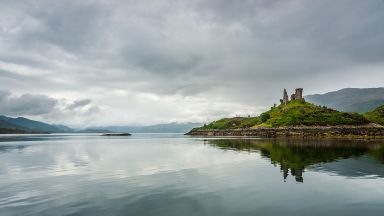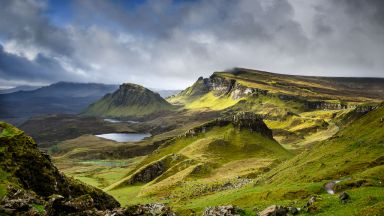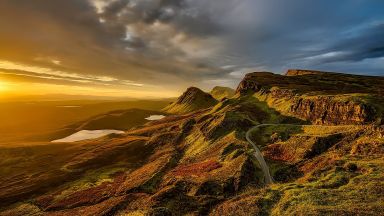Wester Ross: The Complete Guide
With over 3000 square miles of soaring mountains and atmospheric glens, ancient Caledonian forest and wild beaches set against a backdrop of fjord-like lochs; Wester Ross is one of the world’s most spectacular, and remote, regions and probably the most beautiful part of the famous North Coast 500.
Wester Ross is an area of the Northwest Highlands of Scotland in the council area of Highland. The area is loosely defined, and has never been used as a formal administrative region in its own right, but is generally regarded as lying to the west of the main watershed of Ross (the eastern part of Ross being Easter Ross), thus forming the western half of the county of Ross and Cromarty.
Wester Ross has one of the lowest population densities in Europe, with just 1.6 people per km2, who live mostly in small crofting townships along the coastline of the region. The area is renowned for the scenic splendour of its mountains and coastline, and the range of wildlife that can be seen. It is a popular tourist destination, receiving around 70,000 visitors each year.[8] Tourism forms a major part of the economic activity of the area, accounting for 35% of all employment. Other major economic activities in the area include commercial fishing, renewable energy, agriculture and fish farming.
The area gives its name to the Wester Ross National Scenic Area, one of 40 such areas in Scotland, which are defined so as to identify areas of exceptional scenery and to ensure their protection from inappropriate development.
Scenic spots including Loch Maree, Inverewe Garden, Corrieshalloch Gorge, Glen Docherty and the Bealach na Bà. Wester Ross was designated as a Biosphere Reserve under UNESCO’s “Man and the Biosphere” (MAB) Programme in April 2016. The Wester Ross Biosphere Reserve now covers 5,200 square kilometres of Wester Ross and Lochalsh. This new-style biosphere, which covers an area over 100 times larger than the original designation, is a place where people live and actively learn about their surroundings to inspire a legacy rich in both natural and cultural heritage.
Visiting Wester Ross for the first time and wondering what are the top places to see in the city? In this complete guide, I share the best things to do in Wester Ross on the first visit. Top help you plan your trip, I have also included an interactive map and practical tips for visiting!
This website uses affiliate links which earn a small commission at no additional cost to you.
18 Best places to See in Wester Ross
This complete guide to Wester Ross not only tells you about the very best sights and tourist attractions for first-time visitors to the city but also provide insights into a few of our personal favorite things to do.
This is a practical guide to visiting the best places to see in Wester Ross and is filled with tips and info that should answer all your questions!
Beinn Eighe National Nature Reserve

Visiting Beinn Eighe National Nature Reserve
Inverewe Garden

| Hours: Garden, shop, Osgood’s Café, Inverewe House and visitor centre 9.45–16.00 | Price: Adult £13.00 Family £33.00 | Website | Distance: 11.80km
Visiting Inverewe Garden
Flowerdale Glen
Visiting Flowerdale Glen
Gairloch Museum

Location: Gairloch Museum, Gairloch, UK | Hours: Open Easter-October, Mon-Sat 10am-5pm. | Website | Distance: 13.10km
Visiting Gairloch Museum
Torridon Countryside Centre and Deer Museum
Location: Deer Museum Achnasheen IV22 2EW United Kingdom | Distance: 16.60km
Visiting Torridon Countryside Centre and Deer Museum
Laide chapel and graveyard and Laide Wood

Visiting Laide chapel and graveyard and Laide Wood
Shieldaig Peninsula and Island

Visiting Shieldaig Peninsula and Island
Mellon Udrigle Bay

Visiting Mellon Udrigle Bay
Rua Reidh Lighthouse

Visiting Rua Reidh Lighthouse
Corrieshalloch Gorge

Location: Corrieshalloch Gorge National Nature Reserve, Braemore, Garve, UK | Distance: 28.10km
Visiting Corrieshalloch Gorge
Rubha Cadail Lighthouse

Visiting Rubha Cadail Lighthouse
Lochcarron Village

Visiting Lochcarron Village
Attadale Gardens

Location: Attadale Gardens, Attadale Gardens, Strathcarron, UK | Hours: Open – April to end October | Website | Distance: 33.10km
Visiting Attadale Gardens
Applecross Heritage Centre & Clachan Church

| Website | Distance: 33.70km
Visiting Applecross Heritage Centre & Clachan Church
Applecross Broch & the Archaeological Trail

Visiting Applecross Broch & the Archaeological Trail
Strome Castle

Visiting Strome Castle
Stac Pollaidh

Visiting Stac Pollaidh
Eilean Donan Castle

| Hours: 10am-6pm Apr-May & Oct, 9.30am-6pm Jun & Sep, 9am-6pm Jul & Aug, 10am-4pm Nov-Dec & Feb-Mar, closed Jan | Price: adult/child/family £7.50/4/20 | Website | Distance: 46.20km
Visiting Eilean Donan Castle


